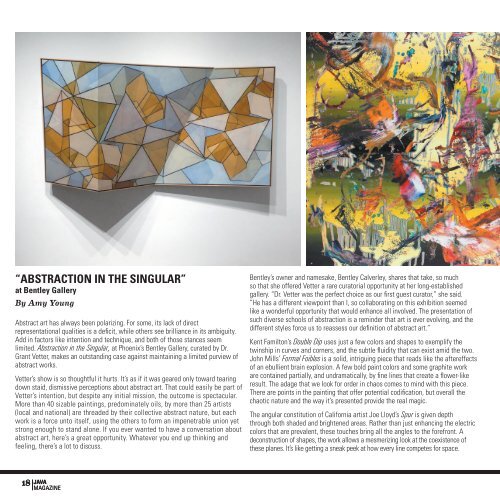Java.March.2017
You also want an ePaper? Increase the reach of your titles
YUMPU automatically turns print PDFs into web optimized ePapers that Google loves.
“ABSTRACTION IN THE SINGULAR”<br />
at Bentley Gallery<br />
By Amy Young<br />
Abstract art has always been polarizing. For some, its lack of direct<br />
representational qualities is a deficit, while others see brilliance in its ambiguity.<br />
Add in factors like intention and technique, and both of those stances seem<br />
limited. Abstraction in the Singular, at Phoenix’s Bentley Gallery, curated by Dr.<br />
Grant Vetter, makes an outstanding case against maintaining a limited purview of<br />
abstract works.<br />
Vetter’s show is so thoughtful it hurts. It’s as if it was geared only toward tearing<br />
down staid, dismissive perceptions about abstract art. That could easily be part of<br />
Vetter’s intention, but despite any initial mission, the outcome is spectacular.<br />
More than 40 sizable paintings, predominately oils, by more than 25 artists<br />
(local and national) are threaded by their collective abstract nature, but each<br />
work is a force unto itself, using the others to form an impenetrable union yet<br />
strong enough to stand alone. If you ever wanted to have a conversation about<br />
abstract art, here’s a great opportunity. Whatever you end up thinking and<br />
feeling, there’s a lot to discuss.<br />
Bentley’s owner and namesake, Bentley Calverley, shares that take, so much<br />
so that she offered Vetter a rare curatorial opportunity at her long-established<br />
gallery. “Dr. Vetter was the perfect choice as our first guest curator,” she said.<br />
“He has a different viewpoint than I, so collaborating on this exhibition seemed<br />
like a wonderful opportunity that would enhance all involved. The presentation of<br />
such diverse schools of abstraction is a reminder that art is ever evolving, and the<br />
different styles force us to reassess our definition of abstract art.”<br />
Kent Familton’s Double Dip uses just a few colors and shapes to exemplify the<br />
twinship in curves and corners, and the subtle fluidity that can exist amid the two.<br />
John Mills’ Formal Foibles is a solid, intriguing piece that reads like the aftereffects<br />
of an ebullient brain explosion. A few bold paint colors and some graphite work<br />
are contained partially, and undramatically, by fine lines that create a flower-like<br />
result. The adage that we look for order in chaos comes to mind with this piece.<br />
There are points in the painting that offer potential codification, but overall the<br />
chaotic nature and the way it’s presented provide the real magic.<br />
The angular constitution of California artist Joe Lloyd’s Spur is given depth<br />
through both shaded and brightened areas. Rather than just enhancing the electric<br />
colors that are prevalent, these touches bring all the angles to the forefront. A<br />
deconstruction of shapes, the work allows a mesmerizing look at the coexistence of<br />
these planes. It’s like getting a sneak peek at how every line competes for space.<br />
18 JAVA<br />
MAGAZINE


















